When it comes to your recruitment team, it’s rare to have too many cooks in the kitchen. Some may argue that a large number of hands in the pot is a good way to stir things up. Others argue that more than a few people in any given hiring process can make the whole endeavor more complicated and messy.
However, if you take the right steps beforehand, a large talent acquisition team can benefit your recruitment team’s goals. This article will explore how to strike the right balance, and create a hiring team structure that’s poised for success.
What is a hiring team?
A hiring team is a group of individuals within an organization that is responsible for fill a vacant position. They manage the entire recruitment process—from sourcing and interviewing candidates to making final hiring decisions.
Hiring teams might be permanent and established departments within an organization, temporary teams that include hiring managers and stakeholders, or a combination of the two. In all cases, hiring teams collaborate closely to ensure a successful hiring process.
Who needs a hiring team?
Not every organization needs a hiring team, or has the resources or staff required to create one. Here’s a breakdown of the types of organizations that would benefit from assembling recruitment teams, and those that can skip this process.
Companies that need hiring teams include:
- Medium-sized to large organizations with a high volume of hiring and complex recruitment process
- Rapidly growing startups that need to scale quickly with consistent, successful, and strategic hiring
- High turnover industry like retail, hospitality, or customer services who have frequent hiring needs
- Specialized or niche industry that need subject matter experts to help with candidate assessment
Companies that likely don’t need—or won’t be able to sustain—hiring teams include:
- Small businesses with low hiring volumes and hiring processes that can be managing by business owners or a single HR professional
- Early stage startups that haven’t begun to ramp up recruitment efforts yet
- Companies that outsource their recruitment rather than using internal teams
Hiring teams offer a range of benefits, and are great at creating scalable and repeatable hiring success. But, companies need to make sure they have the need and resources to sustain these teams before they attempt to expand the complexity of their recruitment efforts.
What does a hiring team do?
Hiring teams are responsible for all key stages of the hiring process—from strategy through to final hiring tasks.
Specific responsibilities include:
- Identifying hiring needs
- Defining the role
- Setting hiring criteria
- Sourcing talent
- Recruitment marketing
- Employer branding
- Resume screening
- Conducting phone screen interviews
- Conducting skills assessments
- Conducting job interviews and candidate evaluations
- Collaborating to make hiring decisions
- Extending job offers
- Conducting pre-employment checks
- Managing the employee onboarding process
Hiring team members may be involved with as few as one of these steps, or actively participate in the entire process. The extent of an individual’s involvement will depend on their role and position within the organization.
For example, a recruiter is likely to serve as the strategic lead on a new hiring campaign. They will be involved from start to finish, overseeing each step outlined above. A stakeholder or subject matter expert, on the other hand, will likely only be involved in the candidate evaluation or interview phases to help validate the candidate’s expertise.
We’ll explore individual roles and responsibilities within the hiring team a bit later in this article.
Keep reading: 20 recruitment terms all recruiters should know about
Benefits of using hiring teams to recruit candidates
Using hiring teams to recruit candidates offers a range of benefits for organizations, ultimately leading to better hiring decisions and more impactful employees in the long run.
Here are five benefits of hiring teams.
1. Collaborative decision-making
Collaborative hiring brings together multiple perspectives from different team members, reducing the chances of bias and improving the overall decision-making process.
By involving recruiters, hiring managers, and team members, organizations can objectively assess candidates against the role’s needs and company culture. This approach ensures a well-rounded evaluation, leading to more informed and balanced hiring decisions.
2. Improved candidate experience
Hiring teams create a more engaging and structured interview process, providing candidates with a positive experience from start to finish.
With clear communication and organized interviews, candidates feel valued and informed at every stage. This enhances your employer brand and increases the likelihood that top talent will accept your offer.
3. Faster and more efficient hiring
With tasks divided among team members, hiring teams can significantly speed up the recruitment process.
Sourcing, interviewing, and decision-making are streamlined, reducing time-to-fill and ensuring that roles are filled promptly. This efficiency helps maintain productivity and keeps the business moving forward.
4. Enhanced team fit assessment
Hiring teams include individuals who will work directly with the new hire, providing unique insights into how well a candidate will fit within the team and contribute to its dynamics.
This first-hand input ensures that the selected candidate is not only technically qualified but also aligns with the team’s work style and culture, leading to better long-term retention.
5. Higher quality of hires
Collaborative recruiting leverages the strengths of different team members, combining various skill sets and expertise to identify the best candidates.
This collective effort often results in higher-quality hires who are better suited to meet the role’s demands and the organization’s goals. By pooling knowledge and perspectives, hiring teams can more effectively pinpoint candidates who have the potential to excel.
Key roles in a recruitment team
To maximize the benefits outlined above, it’s important to include the right people—with the right roles—in your hiring team. Let’s explore those roles now, and each person’s responsibilities.
1. The recruiter(s)
Recruiters arrange the recruitment process from start to finish, including, but not limited to:
- Source, screen, and engage potential candidates.
- Act as the main point of contact for candidates throughout the hiring process.
- Collaborate with hiring managers and interview panel members to refine job descriptions and candidate profiles.
- Provide feedback and recommendations on candidates to the hiring team.
Value added to the recruiting team: Recruiters are generally responsible for the coordination and arrangement of the entire hiring process. They will fill the core role in your hiring team strategy.
“Recruiter” has become a catch-all term for someone who sources candidates and sometimes manages candidate communication. In reality, the recruiter (or recruiters) on your team is probably doing so much more: coordinating and conducting interviews, taking job specs from the business, extending offers to candidates.
Don’t let a multi-faceted role be bogged down by time-crunched tasks. They need assistance from time to time, just like we all do! Make sure to include some team members that overlap into the “recruiter” category.
2. Head of Human Resources or HR Lead
Along with other employee life-cycle tasks, the HR Lead plays an integral role in the recruitment process. Although it can be a bit behind-the-scenes, this role is key for:
- Organizing candidate and employee documents;
- Maintaining the ATS (Applicant Tracking System);
- Ensuring forms are up to date;
- Orchestrating salary and benefits when bringing on a new hire;
- Extending offers to candidates.
Value added to the recruiting team: HR leads provide back-office organization and accuracy. Don’t waste valuable time scrounging around old emails when you could be losing potential talent. HR Leads make sure that everything from candidate resumes to ratings and reviews are correct and available to the hiring team. Organization = sanity in recruitment!
3. Resourcer (or Sourcer)
A resourcer’s job is to find talent that is able to be submitted to appropriate open positions within the company. They are the ones doing a lot of the legwork when it comes to hunting down the right talent for vacancies. This entails:
- Understanding the company’s vision and goals;
- Proactively search for and identify potential candidates using various sourcing tools and platforms.
- Build and maintain a pipeline of qualified candidates for current and future roles.
- Work closely with recruiters to align sourcing strategies with specific hiring needs.
- Share insights on market trends and talent availability with the recruitment team.
Value added to the recruiting team: Resourcers are the ones that provide a steady source of candidates for your vacancies. This is often what people think of when they think of recruitment, in general! However, it takes a team’s involvement in your recruitment to ensure organization and alignment with the company vision.
4. Hiring Manager
A hiring manager is typically the person who has an open position in their department and is directly hiring for that position. They set the recruitment process in motion with tasks including:
- Define the specific requirements for the open role and provide input on the ideal candidate profile.
- Conduct interviews and evaluate candidates' technical skills and cultural fit.
- Collaborate with the recruiter and direct supervisor to make final hiring decisions.
- Provide feedback to the recruitment team to refine the selection process.
- Making the final hiring decision.
Value added to the recruiting team: Hiring managers have extensive knowledge of department needs. They know the open role intimately and most likely be working with the new hire on a day-to-day basis. After the employee is onboarded, they will be directly affecting the hiring manager’s own KPIs and professional goals. For those reasons, it’s important to include this role in your collaborative hiring every time.
5. Core team member(s)
This is another role that can (and most likely should be) divided among several individuals. Core team members are the people that the new hire will work with on a day-to-day basis. Their close relationship with the prospective hire means that they should be heavily involved in the recruitment process in order to ensure the best fit. This includes:
- Showcasing top-performing attitudes to potential hires;
- Communicating the company vision and goals to candidates;
- Interviewing candidates;
- Conducting work trials;
- Giving input to the hiring team on candidate performance;
- Onboarding.
Value added to the recruiting team: Core team members add perspective from future coworkers of the new hire. They can let you know if a candidate just doesn’t jive or seem like they would be able to work well in the environment they’re used to day-to-day!
Finding a top performer in a similar position also allows your recruitment to be that much more honed in and precise. These top performers (or performers) are a valuable asset to your recruitment team, ensuring the new hire will be beneficial and able to perform the required tasks.
6. The direct supervisor
The new hire's direct supervisor should be involved in the hiring process. Even if they are not the ones submitting the requisition for the position to be filled, they will still impact (and be impacted by) the recruitment process.
They likely know the type of person that will thrive in the open position, because they are aware of the ins and outs of the department and requirements. The direct supervisor can inform your hiring team of gaps that need to be filled when sourcing for this new employee. This includes tasks such as:
- Deciding job qualifications;
- Interviewing candidates;
- Conducting work trials;
- Delineating tasks to core team member(s);
- Giving input to the talent acquisition team on candidate performance;
- Onboarding.
Value added to the recruiting team: The direct supervisor provides an on-the-ground perspective and likely has experience finding quality hires in that specific department. They will be crucial in the interview process, as well, as they can determine what type of candidate will excel in their section of the workforce.
7. CEO/Owner
While the CEO of a large corporation isn’t always physically able to greet each and every candidate, they can still have a part in the recruitment process virtually. Whether it is the owner of a large, medium, or small company, within the recruitment process they are responsible for:
- Creating and disseminating the company’s vision and goals;
- Making employees feel included, involved, and important;
- Serving as the positive face of the company;
- Making executive decisions about new hires;
- Guiding the hiring strategy informed by business strategy.
Value added to the recruiting team: The CEO of a company shouldn’t be this enigmatic, intangible figure. If they are honest and apparent to potential hires, this showcases expertise, company values, and a caring toward the company, in general. Remember, you’re not just judging the candidates. They’re judging your company, as well! Team hiring wouldn’t be complete without at least a company vision from the owner, themselves.
8. Recruitment coordinator
The unsung hero of any hiring team is the recruitment coordination. They’re the ones who keep the train on the track throughout the recruitment process, ensuring that all logistical, technical, and administrative tasks are met. In general, they’re responsible for:
- Scheduling interviews and coordinating with candidates and interview panel members.
- Managing communication with candidates to keep them informed throughout the process.
- Collaborating with recruiters and hiring managers to ensure a smooth interview flow.
- Handling administrative tasks such as tracking candidate progress and managing recruitment software.
Value added to the recruiting team: By taking care of these details, recruitment coordinators allow recruiters and hiring managers to focus on evaluating candidates, enhancing overall team productivity and collaboration. Their role ensures a seamless candidate experience, keeps the hiring process on track, and contributes to a well-organized and professional recruitment effort.
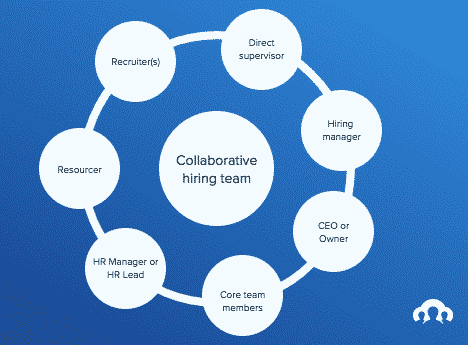
4 best practices for building an effective hiring team
While the benefits of hiring teams are well-established, the process of assembling one isn’t always as cut and dry. You need to make sure that you’re bringing in the right people, in the right roles, and collaborating effectively as a team.
Here are five best practices for building an effective hiring team to get you started on the right foot.
1. Be clear about roles and responsibilities
Ensure each team member has a clearly defined role in the hiring process, such as screening, interviewing, or decision-making. This clarity helps avoid overlaps and ensures accountability.
Document those responsibilities and communicate them to all involved to keep the process organized and efficient.
2. Bring in diverse perspectives
Assemble a hiring team with diverse backgrounds, skills, and perspectives to reduce bias and improve the quality of decision-making. Include individuals who can offer different viewpoints on candidates' fit, both technically and culturally. This diversity fosters more balanced evaluations and supports inclusive hiring practices.
3. Provide training and coaching
Provide training for hiring team members, focusing on interview techniques, unconscious bias awareness, and legal compliance. Regular workshops or briefings can keep the team updated on the latest best practices and tools.
This continuous learning approach improves the effectiveness and professionalism of your hiring team.
4. Establish clear communication channels
Establish your communication cadences and tools that you’ll use to stay aligned as a hiring team. This should include weekly or bi-weekly check in calls, async updates, and instructions for how to record feedback on candidates as the hiring process unfolds.
This ensures all team members are aligned and have access to the latest information on candidates. Effective communication minimizes misunderstandings and keeps the hiring process moving smoothly.
5 challenges faced by hiring teams (and how to overcome them)
Of course, like any collaborative project, working with a hiring team is not without its challenges. Here are five challenges you’re likely to face when establishing and managing a hiring team, with tips on how to overcome them.
1. Lack of role clarity
A common challenge that hiring teams face is confusion over who is responsible for specific tasks. This can lead to missteps during the hiring process, duplicated efforts or, worse, missing critical steps in the process. All of this can both hinder the success of the hiring process, and create a poor candidate experience.
To overcome this, provide a detailed outline of each role’s responsibilities and establish accountability measures. Kick off calls and regular team meetings can also help clarify any role-related questions and ensure that everyone remains aligned throughout the process.
2. Communication breakdowns
Likewise, miscommunication among team members can result in delays, inconsistent candidate evaluations, and a disjointed hiring process.
Overcome this by setting up clear communication processes, as outlined above, such as using shared documents, regular status updates, and dedicated communication channels. Encourage open feedback loops to quickly address any misunderstandings.
3. Differing opinions
While diversity on your hiring team is a positive thing, it can lead to impasses or differences of opinions about which candidates to select and which attributes to place value on.
Address this by establishing standardized evaluation criteria and scoring systems that all team members follow. Facilitate discussions where team members can voice their opinions and collaboratively reach a consensus.
4. Resistance to collaboration
Some team members, especially those new to collaborative hiring, may resist working closely with others, preferring to handle recruitment independently.
To address this, emphasize the value of team-based hiring and provide training on collaborative practices. Foster a culture of cooperation by highlighting successful outcomes from past hiring processes.
5. Time constraints and scheduling conflicts
Coordinating schedules across multiple team members can be difficult, often leading to delays in the hiring process. Use scheduling tools and assign a recruitment coordinator to manage logistics and keep the process on track. Set clear expectations for availability and response times to ensure the team can efficiently coordinate their efforts.
How Recruitee helps to manage hiring teams
To effectively establish and manage hiring teams, you need a centralized and reliable tool that keeps team members aligned and data easily accessible. Recruitee is a collaborative hiring software that’s specifically built to help build successful hiring teams.
With Recruitee, recruiters can create dedicated hiring teams for each new role, and assign roles to all key stakeholders.
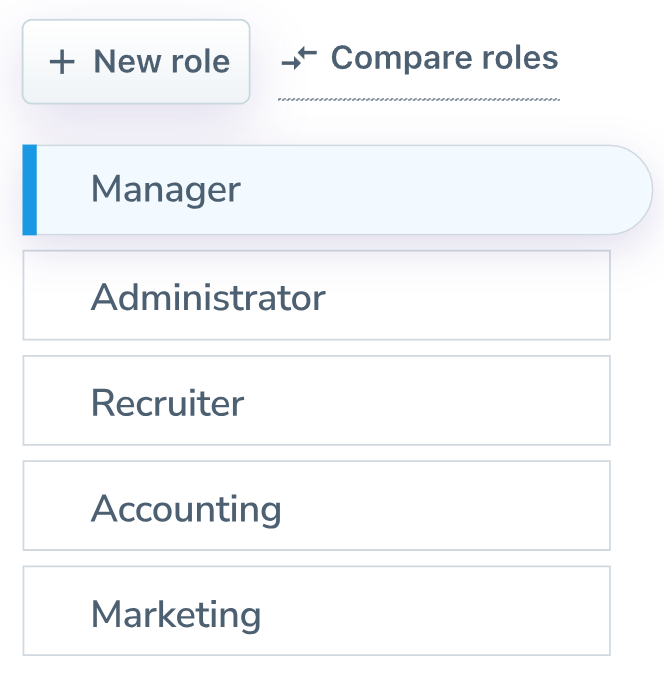
These team members can collaborate and communicate within the Recruitee platform, leaving notes, tags, and mentions on candidate profiles to facilitate better discussions and decision making throughout the screening process.
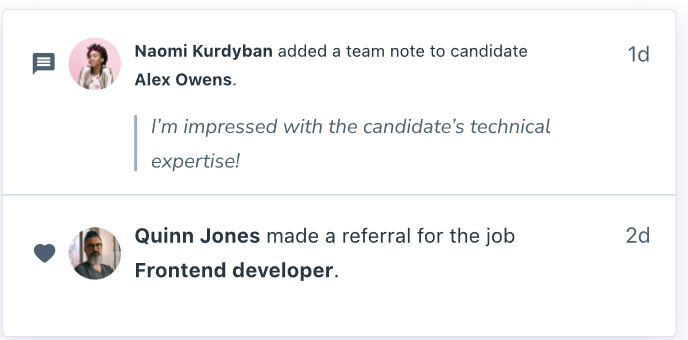
Recruitee also acts as a centralized database for all candidate information, making it easy for recruiters and other team members to access and manage information from a single platform. Candidate pipelines can be created and managed for each job, allowing hiring teams to easily see which candidates are progressing through the process.
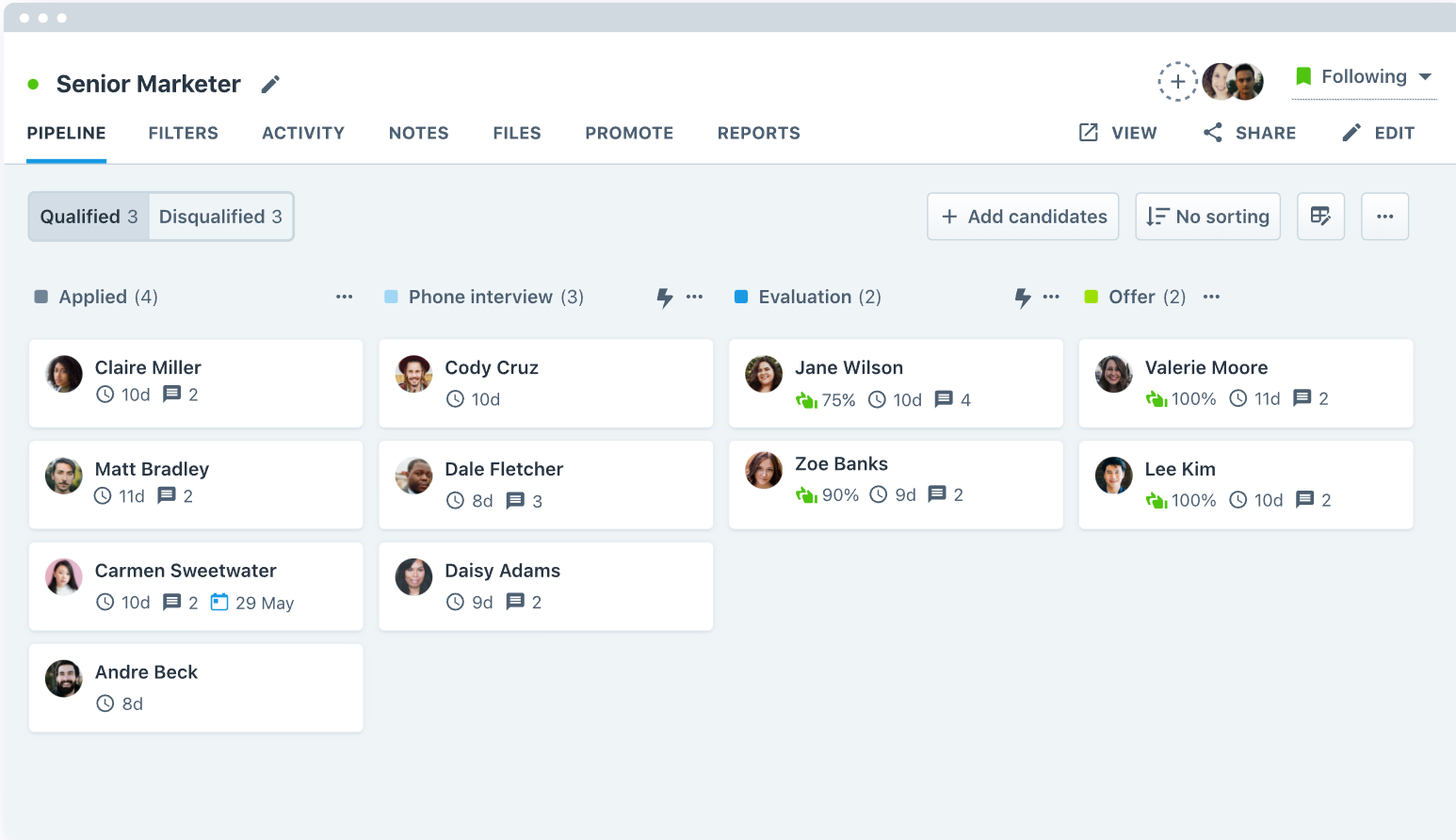
The platform also simplifies scheduling across the hiring team thanks to the event scheduler and Outlook and Gmail integration. With this, recruitment coordinators can share scheduling links with candidates and other hiring team members with prompts to select a meeting time that works for all parties. This reduces back and forth messaging and coordination for each and every candidate.
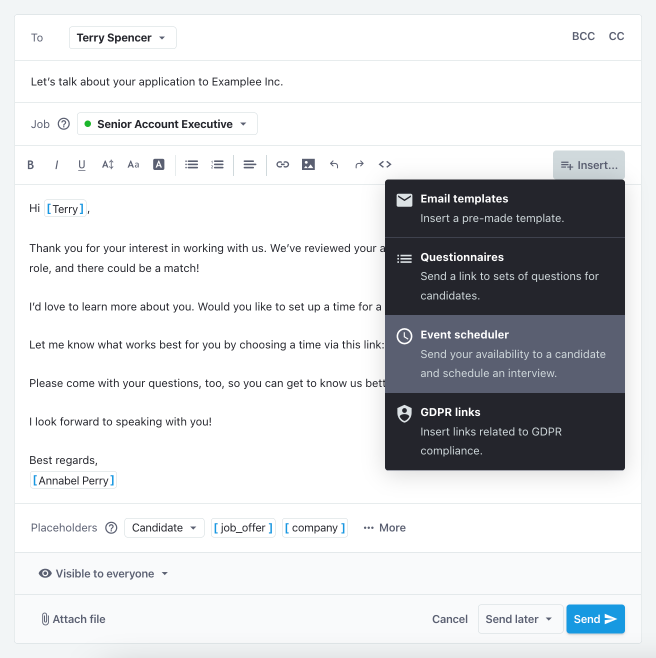
Lastly, a variety of automations and communications templates help to further reduce administrative tasks for hiring teams, allowing them to dynamically create outreach and follow-up emails for candidates, and send them at predetermined times. This ensures that critical candidate touchpoints are met, without an outsize burden falling on one hiring team member.
Working as a team to secure better candidates
We firmly believe that collaborative hiring is the most effective way to hire. But, it’s only as good as the hiring team you assemble, and the processes and tools you use to stay aligned.
When assembling a hiring team, take special care to ensure that you’re engaging the right people within your organization, and taking steps to set them up for success. Establish and refine processes to stay aligned throughout the process, and use tools to help you collaborate effectively.
When done well, hiring teams help you achieve thorough and objective hiring decisions on a scalable and reliable basis. This means better hires, and better results for your organization.
Frequently Asked Questions
- What are the different roles in recruitment?
There are 7 roles in the recruitment team: the recruiter, Head of Human Resources, resourcer, hiring manager, team members, direct supervisor, and CEO.
- What are the benefits of collaborative hiring?
Collaborative hiring decreases the risk of recruiter burnout. Working with multiple people will also lead to better culture fits, efficiency and the company culture will become more inclusive.
- How do you build a recruitment team?
Firstly, you will need to determine which roles your department needs based on long-term organizational goals. You can start hiring new team members to reach these goals and scale your company based on this information.








